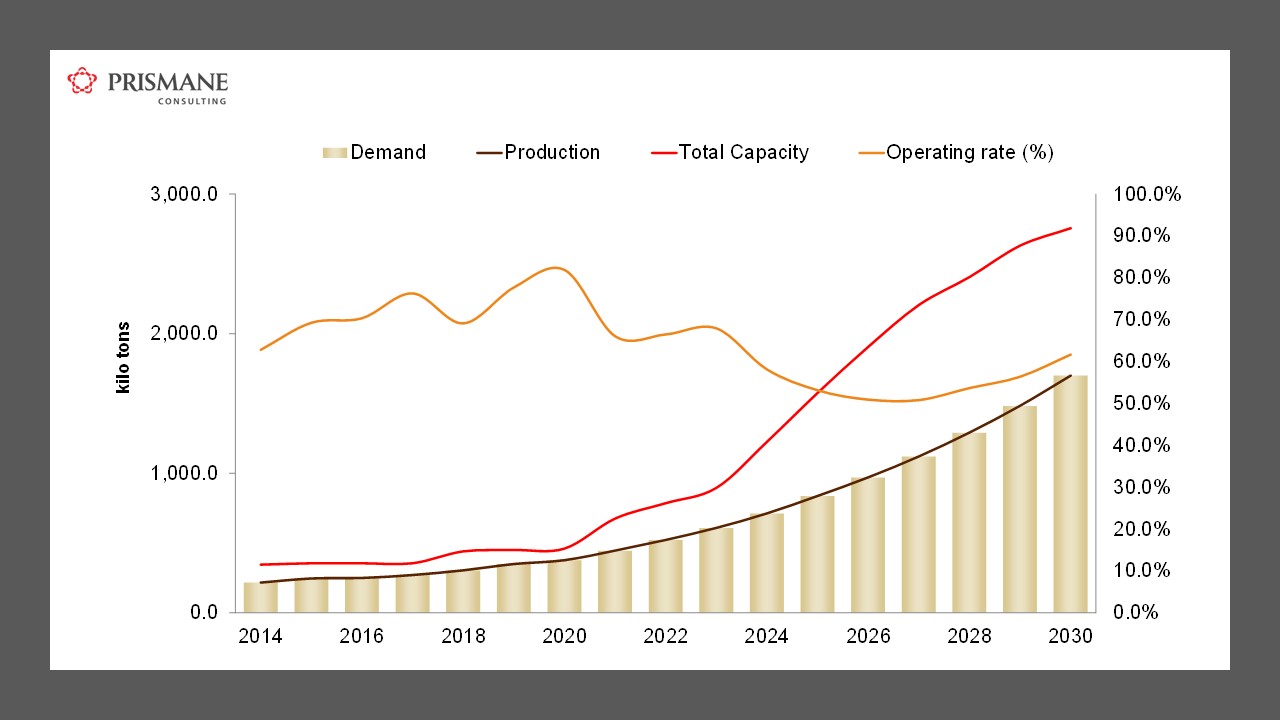Move Towards Sustainability Driving Substantial Polylactic Acid (PLA) Capacity Additions in China
Pune, Maharashtra, India -- 03/11/2021 -- Prismane Consulting is pleased to publish its Global Polylactic Acid (PLA) Market Study Report. This report forms a part of the Bio-Degradable Plastics strategy report recently published by Prismane Consulting.
China to witness a growth of 21% in terms of PLA capacity additions by 2030
Polylactic acid (Polylactic Acid (PLA)) is one of the most important biodegradable thermoplastics which is compostable and completely recyclable.As of 2020, NatureWorks is the largest Polylactic Acid (PLA) producer globally having a capacity of 150 kilo tons in the U.S. The company is also setting up a Polylactic Acid (PLA) facility in Thailand to capture the fast-growing ASEAN and APAC markets. The global Polylactic Acid (PLA) capacity as per Prismane Consulting’s Polylactic Acid (PLA) database is around 461 kilo tons in 2020. NatureWorks accounted for around 33%% of the global Polylactic Acid (PLA) capacity and has been exporting to a number of countries from its facility in Nebraska. Total Carbion is another emerging key player having recently started its 75 kilo tons facility in Thailand and another Polylactic Acid (PLA) facility of 100 kilo tons being constructed in France. A number of capacity expansions are announced in China with a huge wave of new capacities expected during the 14th Five year plan of China (2021-2025). The country’s shifting focus towards more sustainable products will provide a big push not only to the Polylactic Acid (PLA) market but the entire bioplastics / biodegradable polymers market.
The global production capacity in 2020 was about 460 kilo tons, with global demand around 380 kilo tons. The global capacity utilizations rates in 2020 were around 82%. The global operating rates have varied between 62% - 82% between 2014 and 2020. The double-digit growth in China and global acceptance of biopolymers has led to an increase in demand and eventually the operating rates. However, with several capacity additions announced in China, the global PLA plant operating rates are forecast to stoop down from current levels of 82% to 62% globally by 2030.
Ban on single use plastics to drive demand growth during the long-term forecast
The global Polylactic Acid (PLA) market has been segmented on the bases of segment as Automotive, Packaging, Electronics, Textiles, Medical, and other niche applications.Packaging is the largest and one of the fastest growing applications for Polylactic Acid (PLA). The sector accounted for over 60% of the global demand in 2020 and is expected to grow at an annual average of 16% during the long-term forecast. With certain set of standards and certification procedure for Polylactic Acid (PLA) and increased pressure of regulatory and environmental protection agencies in most of the major countries of the world, the use of Polylactic Acid (PLA) to make bottles, containers, blister packaging will continue to rise during the long-term forecast. The factors that are likely to push the demand growth upwards include increasing disposable income and rapid urbanization. The European Union’s decision to reduce the consumption of thin film plastic bags will push demand growth for biodegradable plastics like Polylactic Acid (PLA).
Request/View TOC - Here
During the recent years, developing countries like China, India and other Southeast Asian countries have shown remarkable growth. These countries have been pushing to achieve self-sufficiency in terms of agricultural supplies, as well as increase agricultural export. Multiple governmental initiatives have been launched to increase the local production and facilitate nodes working at root level. Grants for urban agricultural research and implementation of advanced technologies have been observed in these countries.
Others major driver of biodegradable plastics include:
• Innovations in the food & beverage industry
• Growing purchasing power in developing economies & growth of key end-use sectors like automotive, electrical & electronics and consumer goods.
• Comparatively reduced environmental risk
• Research &development, innovation in biodegradable applications in medical implants and drug delivery systems.
• Increased demand and higher penetration of bio-based products in Asia
• Government initiatives, incentives & promotion of biodegradable products.
Request Sample Report- Here
About Prismane Consulting
Prismane Consulting is a global consulting firm serving leading businesses in the field of Chemicals, Petrochemicals, Polymers, Materials, Environment and Energy. We are a leading provider of in-depth technical and management consulting services and have been advising clients on their key strategic issues solving their most critical business problems.
The Chemicals & Energy Practice also offers its clients market studies, strategy and business opportunity assessment reports related to refining, Chemicals, Petrochemicals, Plastic & Polymers, Coatings, Materials, Power & Utilities and other energy sources and products.
Contact Us
Tejas Shah
Prismane Consulting
519, Amanora Chambers, Town Centre Amanora,
Magarpatta Road, Pune – 411028
Maharashtra, India
Email: sales@prismaneconsulting.com

